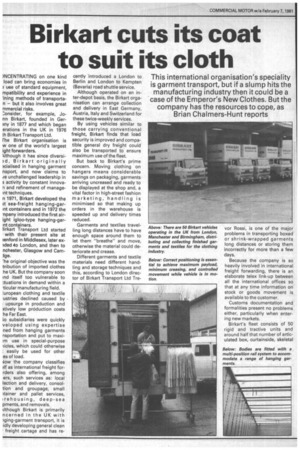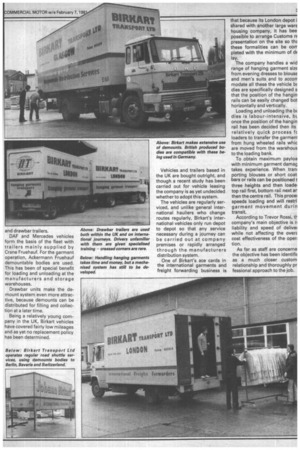Birkart cuts its coat to suit its cloth
Page 40

Page 41

If you've noticed an error in this article please click here to report it so we can fix it.
This international organisation's speciality is garment transport, but if a slump hits the manufacturing industry then it could be a case of the Emperor's New Clothes. But the company has the resources to cope, as Brian Chalmers-Hunt reports
ANCENTRATING on one kind load can bring economies in use of standard equipment, mpatibility and experience in lning methods of transportan — but it also involves great mmercial risks.
L'onsider, for example, Jonn Birkart, founded in Germy in 1877 and which began erations in the UK in 1976 th Birkart Transport Ltd.
rhe Birkart organisation is w one of the world's largest ight forwarders.
klthough it has since diversi Birkart originally )cialised in hanging garment nsport, and now claims to ie unchallenged leadership in 3 activity by constant innova
ni refinement of manageint techniques.
n 1971, Birkart developed the 3t sea-freight hang ing-garint containers and in 1972 the -npany introduced the first airight igloo-type hanging-garTit containers.
lirkart Transport Ltd started with their present site at :enford in Middlesex, later exIded4o London, and then to nchester, Glasgow and Camige.
The original objective was the tribution of imported clothes he UK. But the company soon €nd itself too vulnerable to 3tuations in demand within a licular manufacturing field. iuropean clothing and textile ustries declined caused by upsurge in production and 3tively low production costs he Far East.
;o subsidiaries were quickly veloped using expertise ned from hanging garments ilsportation and put to maxiIrn use in special-purpose • Iicles, which could otherwise : easily be used for other es of load.
,low the company classifies :If as international freight forrders also offering, among ers, such services as: local lection and delivery, consoltion and groupage, small Itainer and pallet services, Irehousing, deep-sea pments, and removals.
Othough Birkart is primarily ncerned in the UK with .iging-garment transport, it is
idly developing general clean
freight cartage and has re
cently introduced a London to Berlin and London to Kempten (Bavaria) road shuttle service.
Although operated on an inter-depot basis, the Birkart organisation can arrange collection and delivery in East Germany, Austria, Italy and Switzerland for these twice-weekly services.
By using vehicles similar to those carrying conventional freight, Birkart finds that load security is improved and compatible general dry freight could also be transported to ensure maximum use of the fleet.
But back to Birkart's prime concern. Moving clothing on hangers means considerable savings on packaging, garments arriving uncreased and ready to be displayed at the shop and, a vital factor in high-street fashion marketing, handling is minimised so that making up orders in the warehouse is speeded up and delivery times reduced.
Garments and textiles travelling long distances have to have enough space around them to let them "breathe" and move, otherwise the material could deteriorate and crease.
Different garments and textile materials need different handling and storage techniques and this, according to London director of Birkart Transport Ltd Tre
vor Rossi, is one of the major problems in transporting boxed or shrink-wrapped garments long distances or storing them incorrectly for more than a few days.
Because the company is so heavily involved in international freight forwarding, there is an elaborate telex link-up between all the international offices so that at any time information on stock or goods movement is available to the customer.
Customs documentation and formalities present no problems either, particularly when entering new markets.
Birkart's fleet consists of 50 rigid and tractive units and around half that number of articulated box, curtainside, skeletal and drawbar trailers.
DAF and Mercedes vehicles form the basis of the fleet with trailers mainly supplied by Crane Fruehauf. For the garment operation, Ackermann Fruehauf demountable bodies are used. This has been of special benefit for loading and unloading at the manufacturers and storage warehouses.
Drawbar units make the demount system even more attractive, because demounts can be distributed for filling and collection at a later time.
Being a relatively young company in the UK, Birkart vehicles have covered fairly low mileages and as yet no replacement policy has been determined.
Vehicles and trailers based in the UK are bought outright, and though a recent study has been carried out for vehicle leasing the company is as yet undecided whether to adopt this system.
The vehicles are regularly serviced, and unlike general international hauliers who change routes regularly, Birkarts international vehicles only run depot to depot so that any service necessary during a journey can be carried out at company premises or rapidly arranged through the manufacturers distribution system.
One of Birkarts ace cards in the international garments and freight forwarding business is that because its London depot i shared with another large ware housing company, it has bee possible to arrange Customs rE presentation on the site so IN these formalities can be corr plated with the minimum of dc lay.
The company handles a wid range of hanging garment size from evening dresses to blouse and men's suits and to accorr modate all these the vehicle Ix dies are specifically designed s that the position of the hangin rails can be easily changed bot horizontally and vertically.
Loading and unloading the b( dies is labour-intensive, bi once the position of the hang in rail has been decided then its relatively quick process f( loaders to transfer the garrneni from hung wheeled rails whic are moved from the warehous to the loading bank.
To obtain maximum payloa with minimum garment damag takes experience. When tram porting blouses or short coat bars or rails can be positioned t three heights and then loadei top rail first, bottom rai: next ar then the centre rail. This procet speeds loading and will restri garment movement durin transit.
According to Trevor Rossi, company's main objective is n liability and speed of delivei while not affecting the over cost effectiveness of the open ti on.
As far as staff are concerne the objective has been identifiE as a much closer custom relationship and thoroughly pr fessional approach to the job,












































































































